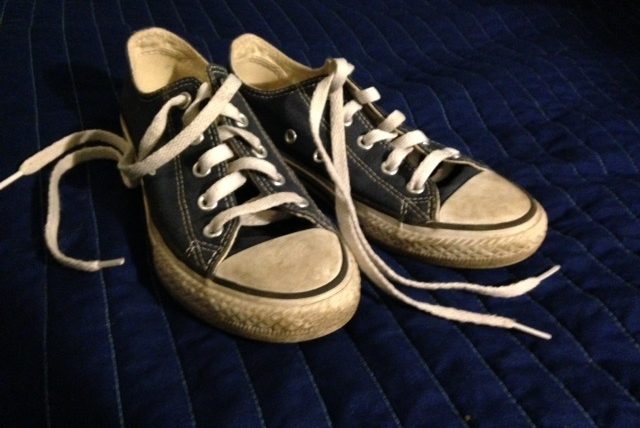
I’ve learned through the years that the only thing that really helps when kids have recurrent problems is empathy and listening. It’s the only way kids can solve their own problems so they stay solved. In our house, a recurrent problem was getting shoes on in the morning. A lot of power was given to shoes and the transitional stress of leaving the house revolved around them. Sometimes they a were too tight, sometimes too loose, sometimes the socks have lumps, are itchy, and sometimes they just didn’t feel right. Other times my son worried they might come untied later or get too hot. Whatever the case, the shoes could ruin a whole morning. The worries and anxieties of the whole day were placed squarely on the shoes. Damn shoes. I’ve learned though, that just listening can be just the connection needed on a hectic morning.
Of course, I knew it wasn’t about the shoes, even he knew it wasn’t about the shoes, but the shoes still bore the brunt of his despair. The shoes were evil. I’ve written about them before and clearly, this struggle is not unique to us because people have told me in droves that their kids’ shoes are evil too. I am not alone in shoe misery. There is plenty of company in Shoe Hell.
In the midst of the infernal regions of shoe perdition, I tried a different tactic. I just listened. I didn’t roadblock my child with solutions, opinions, or an analysis of what was really happening. I just listened— Active listened, to be precise. Active listening in the vein of P.E.T. (Parent Effectiveness Training) is not so different than the empathizing I’ve written about before, but it is a bit more in-depth. It offers space and quiet for your child to figure out his own thoughts. It allows your child to see the real nature of his problem so he can think of solutions on his own. We had the shoe problem resurface a few weeks ago and below is an example of how I handled it through Active Listening.
Active Listening Example

Son: My shoes are too tight!
Me: Ok, let’s loosen them.
Son: Now they are too loose! We’re not ever going to get them right!
Me: (Realizing emotions are flooding) Wow, you sound really worried they won’t ever be right!
Son: YES! They won’t be! I hate tie shoes! They’re the worst, they are too complicated. They are such a pain!
Me: I can tell. It’s way too hard a thing to deal with before school.
Son: I know! I hate them, but they are such cool shoes and they are really comfortable. What should I do?
(It’s important to note here that at this point I really wanted to tell him to just “Put on the velcro shoes already!” but if I had I never would have found out what the real problem was….)
Me: Hmm…. So you really like them but they are such a hassle. You aren’t sure what to do!
Son: Quiet for a full minute then…. My friend always leaves his shoes on during dance class. What should I do? What would you do?
Me: (Admittedly thrown for a bit of a loop) Huh. I’m not sure. You really want me to solve this problem for you.
Son: Yes! What should I do?
Me: I’m not sure. It sounds like your friend leaves his shoes on during dance class. You seem really worried about dance class.
Son: Yes. We always take our shoes off during dance class, but not my friend—he leaves them on.
Me: You’re pretty anxious that if you take your shoes off that you won’t be able to tie them afterwards.
Son: Right! My teacher hurt her wrist and always gets them too tight because of her cast.
Me: I see. There’s no one at school you feel can tie your shoes just right.
Son: No, but it’s not a big deal if we don’t have dance, because we can double knot them. Is there dance today? What should I do?
Me: If you don’t have to take your shoes off at dance you would feel better.
Son: Yes, a lot better. (Long silence) But…even if there IS dance today, I think I could leave them on because my friend always leaves his on. I’m pretty sure I can leave them on too, if he does. I’ll just tell the teacher I don’t want to take my shoes off either.
Me: You sound like you know what to do. Are you ready to go now?”
Son: Yeah!
And then I tied his shoes without struggle. BOOM.
Benefits of Listening

This conversation took about five minutes, which we happened to have to spare this particular morning. It was especially difficult to not offer a solution (roadblock) when he specifically asked for one, but I knew that wasn’t really what he needed. He needed the right solution for him, not the right solution I would have chosen for him. It’s not possible to choose the right solution for someone else, because as happened here, you often don’t know the underlying problem. Another issue I have with offering solutions is that the solution that feels right to you may be the completely wrong solution for someone else, even if that someone else is your child. This is where trusting your child to know himself best is an important skill. In this case, what I was tempted to say would have completely stopped his process because the problem was about dance class—not about getting his shoes right.
I’d be lying if I said this way of listening stopped every “shoe morning,” but it has decreased the conversations by half. The real problems are surfacing much faster. His self-awareness has improved, along with my morning mood.
Biting your tongue and not offering help can be hard when you see your kids struggling. It is human nature to want to help. I’m learning more every day, however, that help comes in many forms, and more often than not, solving is not really helping. Listening is helping. Listening offers the gift of understanding. Not only does it help your child to feel understood by you, it enables them to understand themselves, thereby raising competent and capable adults. I happen to think the world could use a few more competent adults.
Links I think you might like:
Attitudes Required to Use Active Listening
Just Tell Me You Understand – Janet Lansbury

Thank you so much for this clear, detailed and powerful illustration and explanation of how active listening works and why it is so important. From a P.E.T. instructor
Thank you Janine!